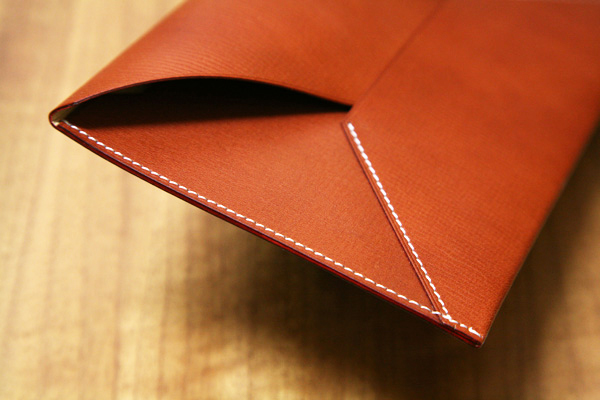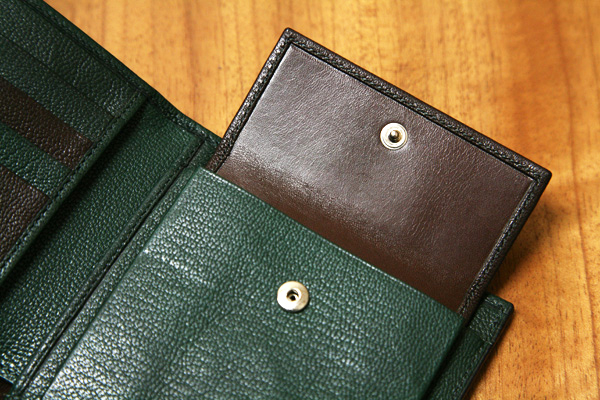
ベタ貼り
皮革製品の最高の贅沢と言われるこの技法は、あらゆる利点を兼ね備える。
それぞれの繊維方向の違う2枚を貼合わせる事に依り非常な堅牢度を示す。
従って極薄なものを造り上げる事ができる。そして、まるで薄くスライスしたゴムの板の様な柔軟性が生まれる。
博庵は、殆どの製品に全面、若しくは必要部分にベタ貼り加工を施してあります。
Full bonding This technique is said to be the most luxurious for leather products, and carries all the benefits. Combining two sheets of leather with different fiber directions brings about extreme robustness. Therefore, it becomes possible to make a very thin product. Such product also has flexibility like a thinly sliced rubber plate. We use the full-bonding technique for almost all the products, either totally or partially, as required.
コバのミガキ
博庵の製品は"切り目"と呼ばれる手法が殆どを占める。
切り目とは、コバが裁断された姿で出来上がっている物。
しかし、裁断されたままでは製品と呼ぶにふさわしくない物になる為裁断面をミガキと呼ばれる処理加工を施す。
この加工はその名の通りコバ面を実際に布によってミガキ上げるのである。
世に出回る殆どの商品が、コバ面に塗料を塗布して仕上げる手法に依るものである。
博庵は敢えてこのコバ処理に古来からの手法に依る染料にて着色し、その後コバミガキで仕上げている。
このコバミガキは非常に労力を要する為、世界的に観て殆ど行なわれていない。
ついでにもう一つ付け加えておこう。現在"本ミガキ"という言葉をよく耳にするが、本来"本ミガキ"という言葉は存在せず前述した塗料の塗布をミガキと間違えて呼ぶ様になったので、実際ミガキをかけたものを本ミガキと呼ぶ様になったのではないかと思われる。

Polishing of edge We use a technique called "cut edge" for almost all the products. Cut edge means a sharp edge that leather has just after being cut. A leather product needs to have such a sharp edge processed by another technique called "polishing". As the name suggests, polishing uses a cloth to polish sharp edges, making them smooth. Almost all the leather products in the world have a different finish. They apply paint to edges to finish. On the contrary, we use a traditional technique: dye the edges and then polish them with a cloth to finish. Because this traditional technique requires a lot of labor, it is rarely performed around the world. Let us add one more thing. Currently, you often hear the words "Hon Migaki" (true polishing) instead of "Migaki" (polishing) . There is no such thing like true polishing, but it was devised because painting edges as described above began to be called "polishing" by mistake. So we guess people wanted to distinguish genuine polishing from 'polishing'.
ヘリの後切り
コバの処理には前述の切れ目があり、そして表革を内側に返すヘリ返しとがある。
博庵の商品は九分九厘切り目の手法を採っているが内装に対してはヘリ返しが殆どである。
このヘリ返しの際にヘリを返した後、ミシンの糸の際ギリギリに余分なヘリを裁断してヘリ幅を細くみせるという手法の事である。
この手法は古来ヨーロッパで育った手法であり日本には存在しないものである。
どんな巨匠と言われる画家であっても、キャンバスのまま壁に掛けたところで絵にはならないものである。
やはり素敵な額縁に入れない限り売り物にはならないであろう。
この額縁に博庵は着眼し、ヘリ切りの手法を採っている。

Post-cutting of edge In addition to cut edge, there is another technique to treat an edge called bagged edge in which the surface leather is turned inside. We use cut edge for almost all the products but for inner treatment, we use the bagged edge technique for almost all the cases. In this technique, after bagging an edge, the margin of the edge should be cut along the closest possible line to the stitching to make the edge look as thin as possible. This technique was originally developed in ancient Europe and it didn't exist in Japan. A painting even by a greatest master will be of little value if only the canvas is hung on the wall. As merchandise, it will not attract people unless it is decorated in a fine frame. We noted this idea of a frame and adopt the technique of edge cutting.
